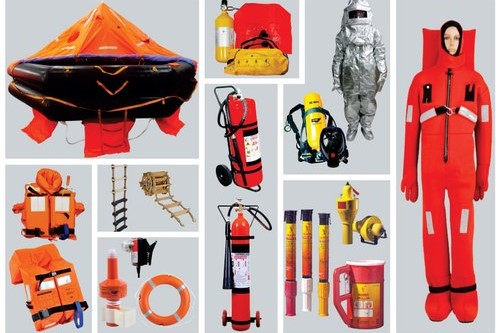In the maritime context, the concept of safety extends far beyond routine operations. The harsh reality of unpredictable oceanic environments necessitates a thorough approach to emergency preparedness, which includes equipping vessels with reliable life rafts and fire fighting appliances. These devices are not just tools; they are lifelines that enhance the resilience of a vessel and safeguard lives in critical situations. Choosing the right life rafts and fire fighting appliances requires an understanding of both the equipment’s technical specifications and the nature of maritime hazards.
The Role of Life Rafts in Maritime Safety
Life rafts represent a fundamental component of survival strategy for those at sea. These inflatable devices are crafted to sustain individuals in open waters, providing temporary refuge in cases of ship abandonment. The choice of life raft is highly contextual, hinging upon the intended range of navigation, anticipated environmental conditions, and vessel type.
A well-chosen life raft will have several key features that directly impact its effectiveness during prolonged exposure to oceanic conditions. These features serve to stabilize, protect, and support those who rely on it until rescue efforts can be completed.
Differentiating Liferaft Types: Coastal, Offshore, and Ocean-Going
Life rafts are classified into three primary categories, each suited to distinct navigational environments:
- Coastal Life Rafts: Designed for short-range, nearshore voyages, coastal life rafts are typically smaller and more compact, providing basic flotation and weather protection. They are suitable for calmer waters close to the shore, where the risk of severe environmental challenges is minimized. However, they lack the robust features needed for extended survival in the open sea.
- Offshore Liferafts: These rafts cater to vessels operating at intermediate distances from shore and are designed to withstand moderate sea conditions. Offshore life rafts are more durable and generally include stability features like ballast pockets, improved buoyancy, and emergency survival kits. These elements make them reliable for waters with potential, but not extreme, hazards.
- Ocean-Going Life Rafts: Engineered for vessels traversing deep, open oceans, these life rafts are the most advanced in terms of durability and safety features. They are equipped with insulated floors, reinforced walls, multiple flotation chambers, and comprehensive survival supplies, ensuring survival support for extended periods in challenging sea conditions.
Choosing the correct type of life raft aligns not only with the nature of the voyage but also with regulatory standards, especially for vessels that carry passengers or traverse long distances in remote waters.
Critical Features for Optimal Life Raft Functionality
The functionality of a life raft depends on specific design elements that ensure stability, protection, and visibility. Ballast systems provide stability, which is essential in rough waters, as they prevent the raft from capsizing in high waves. Insulated floors are another vital feature, particularly in colder climates, to prevent rapid heat loss among occupants, reducing the risk of hypothermia. A canopy that shelters from both sun and precipitation is indispensable, while reflective materials improve visibility, aiding rescue efforts.
Fire Fighting Appliances: An Essential Defense Against Maritime Fires
Fires present a unique and acute risk on vessels, as enclosed spaces, fuel, and electrical systems create an environment where even a small fire can escalate quickly. Fire fighting appliances are, therefore, essential for minimizing the damage caused by fires and, in some cases, allowing for containment until the source can be eliminated.
A well-equipped vessel should carry various fire fighting appliances tailored to address different types of fires. Key tools include fire extinguishers, fire hoses, and, in certain vessels, built-in sprinkler or gas suppression systems. These appliances serve to protect critical areas like engine rooms, where fire risk is particularly high.
Selecting the Appropriate Fire Fighting Appliances
Fire fighting appliances are classified by the type of fire they are designed to combat:
- Class A Fires: Combustible solids such as wood and fabric can be extinguished using water or foam extinguishers.
- Class B Fires: Fires fueled by flammable liquids, such as oil and gas, are best tackled with foam or CO₂ extinguishers to suppress oxygen without spreading the flammable liquid.
- Class C Fires: Electrical fires pose a unique risk, as water-based extinguishers can cause electrical hazards. CO₂ extinguishers are effective here as they leave no conductive residue.
- Class D Fires: Combustible metals, though uncommon on many vessels, require specialized extinguishers and knowledge for safe handling.
A thoughtful selection of fire fighting appliances ensures that each type of potential fire is addressed by the correct extinguisher or suppression system, providing the highest degree of protection.
Maintenance and Crew Training: The Backbone of Emergency Readiness
Selecting the right life rafts and fire fighting appliances is only part of a comprehensive safety plan. Regular inspection, testing, and maintenance of these devices ensure that they remain effective and functional. Life rafts require routine checks for punctures, inflation capabilities, and survival kit contents, while fire fighting appliances must be inspected for pressure and expiration.
Furthermore, well-trained crew members are crucial. Conducting regular emergency drills on the correct use of life rafts and fire extinguishers is essential for reducing response times and promoting calm, organized action in emergencies.
Conclusion: Building a Resilient Safety System
Emergency preparedness on the water requires a layered approach that combines the right equipment with consistent maintenance and training. By choosing life rafts and firefighting appliances carefully, based on voyage needs and safety regulations, vessel operators not only comply with maritime standards but also create a resilient defense against potential dangers. A well-prepared vessel ensures that crew and passengers are protected and capable of responding effectively in critical situations, embodying the essence of proactive maritime safety.


